Medieval Sword Glossary
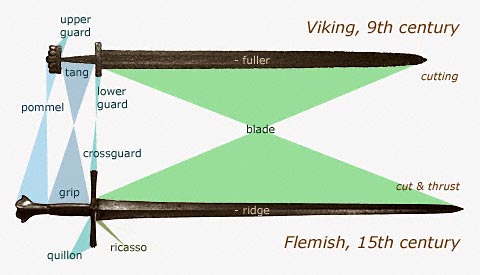

![]() blade refers to the "working"
part of the sword, being essentially a form of the inclined plane.
While the blades of medieval Europe are generally straight and
have two sharpened edges,
single edged forms are also known, particularly from the Viking
Age. Outside of the European Middle Ages, a diversity of blade
forms may be encountered including curved double edged blades
such as the shotel, curved blades with the cutting edge
on the convex side of the curve such as the saber, curved blades
with the cutting edge on the concave side of the curve such as
the yataghan and undulating double edged blades such as
the keris. Non-edged blades also exist, such as the estoc.
Very early blades were often of Bronze, with the transition to
iron and steel occurring at about 700 to 500 BC.
blade refers to the "working"
part of the sword, being essentially a form of the inclined plane.
While the blades of medieval Europe are generally straight and
have two sharpened edges,
single edged forms are also known, particularly from the Viking
Age. Outside of the European Middle Ages, a diversity of blade
forms may be encountered including curved double edged blades
such as the shotel, curved blades with the cutting edge
on the convex side of the curve such as the saber, curved blades
with the cutting edge on the concave side of the curve such as
the yataghan and undulating double edged blades such as
the keris. Non-edged blades also exist, such as the estoc.
Very early blades were often of Bronze, with the transition to
iron and steel occurring at about 700 to 500 BC.
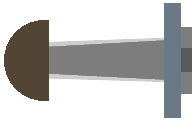 crossguard (see also lower guard or quillon) refers to the element
of the hilt adjacent to and perpendicular to the blade. While
a straight bar of iron or steel with a central inletting for
the tang
of the blade to pass through was commonly employed, variously
curved and tapering forms are also encountered. In some Migration
Period swords, the crossguard will be composed of a sandwich
of organic material such as wood, horn or bone between two metal
plates.
crossguard (see also lower guard or quillon) refers to the element
of the hilt adjacent to and perpendicular to the blade. While
a straight bar of iron or steel with a central inletting for
the tang
of the blade to pass through was commonly employed, variously
curved and tapering forms are also encountered. In some Migration
Period swords, the crossguard will be composed of a sandwich
of organic material such as wood, horn or bone between two metal
plates.
edge is the term applied to the sharpened cutting part of the blade where the two relatively flat faces of the blade intersect at an acute angle to form a variant of the basic tool known as the inclined plane. Most European medieval swords, as well as their predecessors, are symmetrical about the long axis and have two edges which begin at or very near the crossguard and join at point (the distal most tip of the blade). In swords which are made in a composite or piled structure, the hardest steel (highest carbon content) will be applied at the edge. Such hardness as permits a superior edge in terms of cutting quality carries with it an increased brittleness. The swords of this period were used directly against the opponent's body or shield and would not have lasted long if employed in the edge to edge manner so popular in swashbuckling movies.
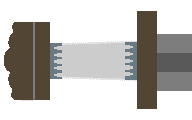 ferrule refers to metallic, often bronze,
bands or rings overlying and retaining the opposite ends of the
grip. On much later swords, ferrules of intricately interwoven
wire are termed Turk's heads, a metaphor remaining from
the time when turbans were in style in Turkey.
ferrule refers to metallic, often bronze,
bands or rings overlying and retaining the opposite ends of the
grip. On much later swords, ferrules of intricately interwoven
wire are termed Turk's heads, a metaphor remaining from
the time when turbans were in style in Turkey.
forte is a term applied to the third to half of the blade nearest the hilt, where strength is greatest.
![]() fuller refers to
the central shallow on a straight double edged blade and or to
lengthwise grooves such as may otherwise be seen on the face(s)
of a blade. Aside from decorative intents, the purpose is to
minimize blade weight with a minimal sacrifice of strength, much
like an I beam. ("Blood gutter" is a misnomer which
should generally be avoided by those seeking to avoid giving
the impression of ignorance).
fuller refers to
the central shallow on a straight double edged blade and or to
lengthwise grooves such as may otherwise be seen on the face(s)
of a blade. Aside from decorative intents, the purpose is to
minimize blade weight with a minimal sacrifice of strength, much
like an I beam. ("Blood gutter" is a misnomer which
should generally be avoided by those seeking to avoid giving
the impression of ignorance).
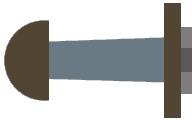 grip refers to the portion of the hilt
assembly covering the tang which is grasped by the sword bearer's
hand. Grips may be contoured for security and comfort and or
after fashion. A core of wood or horn usually forms the bulk
of the grip, although metal is not unknown, covering the narrower
tang. Wood and horn were likely chosen for their shock absorbing
capabilities as well as for workability. In medieval European
contexts, most often this core is a single cylinder of wood,
painstakingly hollowed out to snugly fit over the tang. In other
examples, two wooden halves join in the plane of the edges of
the blade. The core of the grip was usually covered with leather;
coverings of metal plates, wire and fabric are also sporadically
encountered.
grip refers to the portion of the hilt
assembly covering the tang which is grasped by the sword bearer's
hand. Grips may be contoured for security and comfort and or
after fashion. A core of wood or horn usually forms the bulk
of the grip, although metal is not unknown, covering the narrower
tang. Wood and horn were likely chosen for their shock absorbing
capabilities as well as for workability. In medieval European
contexts, most often this core is a single cylinder of wood,
painstakingly hollowed out to snugly fit over the tang. In other
examples, two wooden halves join in the plane of the edges of
the blade. The core of the grip was usually covered with leather;
coverings of metal plates, wire and fabric are also sporadically
encountered.
hilt refers to the handle of a sword to collectively include the guard, grip, pommel, etc. The styles of hilt are often the basis of classification of swords, as is the case with the Viking Age, and provide clues as to where and when a particular sword may have been hilted. Just as old sword blades might be rehilted to suit the tastes or changing fortunes of owners, hilt components would likely be reused when blades were no longer serviceable.
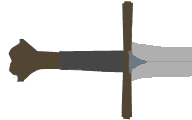 langet
refers to an extension of the crossguard towards the blade which
overlies the base of the blade, leaving room for the mouth of
the scabbard to slip in-between. This is usually a feature of
later swords and, besides being a decorative element, may serve
both to secure the sword within the scabbard as well as acting
as a rain guard.
langet
refers to an extension of the crossguard towards the blade which
overlies the base of the blade, leaving room for the mouth of
the scabbard to slip in-between. This is usually a feature of
later swords and, besides being a decorative element, may serve
both to secure the sword within the scabbard as well as acting
as a rain guard.
 lower guard is a term generally used in
conjunction with hilts of the Viking Age or Migration Period
and refers to the crossguard (or hilt element between the forte
of the blade and the grip). Among Viking Age swords iron is most
frequently encountered as the base metal of which the lower guard
is made, although it may be covered with bronze, silver or gold,
often applied in narrow strips. Solid bronze lower guards may
also be found. In some cases the lower guard will be of iron,
while the upper guard and or pommel will be fashioned of a softer
metal. See also upper
guard and crossguard
lower guard is a term generally used in
conjunction with hilts of the Viking Age or Migration Period
and refers to the crossguard (or hilt element between the forte
of the blade and the grip). Among Viking Age swords iron is most
frequently encountered as the base metal of which the lower guard
is made, although it may be covered with bronze, silver or gold,
often applied in narrow strips. Solid bronze lower guards may
also be found. In some cases the lower guard will be of iron,
while the upper guard and or pommel will be fashioned of a softer
metal. See also upper
guard and crossguard
point refers to the sharp tip or end of a sword blade, opposite the hilt (or handle). Cutting swords, such as those of the Viking Age, will be balanced for an effective cutting or slashing stroke and usually have rounded, sharpened, spatulate points. Such swords were used against an opponent defended by shield, helmet and light body armour including components such as chain mail, leather or padded fabric. The development of heavy plate armour was so effective against the cutting sword that the manner of use of the sword adapted towards the thrust, in which case a strong sharp point became the most critical feature in sword design. Cut and thrust swords include a sharp and robust point along with two long sharp edges, however, the balance will usually have been shifted back towards the hilt to favor maneuverability over momentum. Late in the medieval period, specialized swords called estocs or tucks appear which are essentially a tapered steel rod, triangular or square in section, extending from hilt to a sharp point. While the triangular cross-section, if hollow ground, would permit three narrow edges, albeit useless for cutting, the square cross-sectioned blades were edgeless.
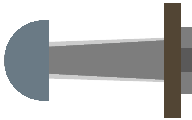 pommel refers to the finial, disc or knob
which terminates the uppermost (as worn vertically) part of the
hilt and which is opposite the blade. The pommel serves to reinforce
and secure the user's grip on the hilt and also serves as a counterweight
to the blade, bringing the center of gravity closer to the hilt.
While pommels are found on bronze swords and may be prominent
on Hallstatt or Roman swords, interestingly, in the Migration
Period many swords lack a pommel, per se, with the upper portion
of the hilt being formed of a tang button securing an upper guard
to the tang of the sword. Viewing the sequence of development
through the Migration Period into the Viking Age, it appears
that in this context pommels may have re-evolved through a continuous
enlargement of this tang button. Earlier Viking Age swords will
have both a pommel and adjacent upper guard, but in later examples
the upper guard and pommel become fused to form a single element
which retains the name pommel and it is this from which
the later medieval forms develop. The schematic depicts a pommel
such as may be seen on a late Viking Age sword. By the early
Norman Period, brazil nut and disc shaped pommels better contoured
to comfortably secure the grip will be adopted. As a generalization,
the counterbalancing function becomes increasingly prominent
as the medieval era progresses. At the very end of the medieval
period, tang buttons reappear as a hilt feature and secure pommels
which are pierced or slotted to slide onto the end of the tang.
While pommels formed of wood, bone, stone and crystal are known,
metals such as iron or bronze are most frequently encountered.
pommel refers to the finial, disc or knob
which terminates the uppermost (as worn vertically) part of the
hilt and which is opposite the blade. The pommel serves to reinforce
and secure the user's grip on the hilt and also serves as a counterweight
to the blade, bringing the center of gravity closer to the hilt.
While pommels are found on bronze swords and may be prominent
on Hallstatt or Roman swords, interestingly, in the Migration
Period many swords lack a pommel, per se, with the upper portion
of the hilt being formed of a tang button securing an upper guard
to the tang of the sword. Viewing the sequence of development
through the Migration Period into the Viking Age, it appears
that in this context pommels may have re-evolved through a continuous
enlargement of this tang button. Earlier Viking Age swords will
have both a pommel and adjacent upper guard, but in later examples
the upper guard and pommel become fused to form a single element
which retains the name pommel and it is this from which
the later medieval forms develop. The schematic depicts a pommel
such as may be seen on a late Viking Age sword. By the early
Norman Period, brazil nut and disc shaped pommels better contoured
to comfortably secure the grip will be adopted. As a generalization,
the counterbalancing function becomes increasingly prominent
as the medieval era progresses. At the very end of the medieval
period, tang buttons reappear as a hilt feature and secure pommels
which are pierced or slotted to slide onto the end of the tang.
While pommels formed of wood, bone, stone and crystal are known,
metals such as iron or bronze are most frequently encountered.
quillion
is the term for each of the projecting limbs of the crossguard;
the typical European medieval sword has two quillons. The part
of the crossguard extending around the tang of the blade is referred
to as the quillon block.
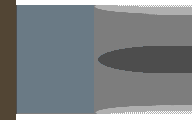 ricasso refers to an unsharpened area at
the root of the blade immediately adjacent to the guard and forming
a transition between the sharpened portion of the blade and the
tang. While late medieval blades, particularly those formed by
stock removal (grinding), may have a short ricasso, ricassos
are usually a feature of Renaissance and later blades, and should
raise suspicions in the context of an earlier blade style. The
area of the ricasso is likely slightly thicker than the sharpened
part of the blade and may be of the same width or narrower or
wider. Fullers usually do not extend into the ricasso. Maker's
marks may frequently be found on the ricasso.
ricasso refers to an unsharpened area at
the root of the blade immediately adjacent to the guard and forming
a transition between the sharpened portion of the blade and the
tang. While late medieval blades, particularly those formed by
stock removal (grinding), may have a short ricasso, ricassos
are usually a feature of Renaissance and later blades, and should
raise suspicions in the context of an earlier blade style. The
area of the ricasso is likely slightly thicker than the sharpened
part of the blade and may be of the same width or narrower or
wider. Fullers usually do not extend into the ricasso. Maker's
marks may frequently be found on the ricasso.
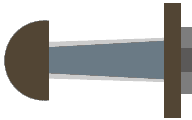 tang refers to the unsharpened end of the
sword blade which, in use, is covered by the grip and other components
of the hilt or handle. The tang will usually taper in width and
thickness from the area of the lower guard or quillion block
towards the pommel. The heat treatment of the tang will favor
malleability (or bendability) over the brittleness which accompanies
increasing hardness. In some cases, the tang will even be of
different composition and welded to the root of the blade. Maker's
marks may occasionally be found on the tang.
tang refers to the unsharpened end of the
sword blade which, in use, is covered by the grip and other components
of the hilt or handle. The tang will usually taper in width and
thickness from the area of the lower guard or quillion block
towards the pommel. The heat treatment of the tang will favor
malleability (or bendability) over the brittleness which accompanies
increasing hardness. In some cases, the tang will even be of
different composition and welded to the root of the blade. Maker's
marks may occasionally be found on the tang.
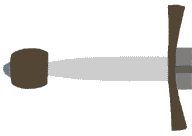 tang
button (tang nut) refers to a retaining device mounted
on the end of the tang in order to hold the hilt in place. In
some cases the tang button will be firmly affixed to the tang,
in others, the end of the tang will have been peened (expanded)
over the tang button to hold it and the hilt assembly together
and in place. Not all European medieval swords will have a tang
button; in many cases the end of the tang will have been peened
directly over the pommel. In other cases the pommel will have
been sweated (joined by heat) to the end of the tang. In the
case of Viking Age swords having both a pommel and an upper guard,
the upper guard will have been fixed to the tang in one manner
or another and the partially hollow and often decorative pommel
then riveted or otherwise affixed to the upper guard.
tang
button (tang nut) refers to a retaining device mounted
on the end of the tang in order to hold the hilt in place. In
some cases the tang button will be firmly affixed to the tang,
in others, the end of the tang will have been peened (expanded)
over the tang button to hold it and the hilt assembly together
and in place. Not all European medieval swords will have a tang
button; in many cases the end of the tang will have been peened
directly over the pommel. In other cases the pommel will have
been sweated (joined by heat) to the end of the tang. In the
case of Viking Age swords having both a pommel and an upper guard,
the upper guard will have been fixed to the tang in one manner
or another and the partially hollow and often decorative pommel
then riveted or otherwise affixed to the upper guard.
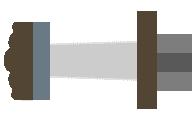 upper guard, like lower guard, is used
in the context of Migration Period and Viking Age swords and
refers to that element of the hilt adjacent to the grip but opposite
the blade, and lying between the grip and pommel (on those swords
where pommels are also present). The upper guard is usually shorter
than the lower guard and decorated in a similar manner.
upper guard, like lower guard, is used
in the context of Migration Period and Viking Age swords and
refers to that element of the hilt adjacent to the grip but opposite
the blade, and lying between the grip and pommel (on those swords
where pommels are also present). The upper guard is usually shorter
than the lower guard and decorated in a similar manner.